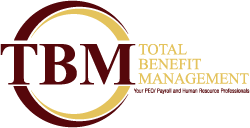- Total Benefit Management

Common Payroll Questions – Answered!
February 11, 2022
What is Corporate Compliance and Why Does It Matter?
April 27, 2022Understanding the 3 Phases of Human Resources Management
Businesses should prioritize establishing excellent total human resources management processes in their organization to ensure that every employee is equipped with the tools and knowledge to perform at their best. HR processes should include three primary phases: pre-hiring, training, and post-hiring (which can also include employer or employee-initiated termination).
Today, we will discuss each phase of the HR management process in detail and offer some tips for your own business’s operations. Let’s begin with the first phase: pre-hiring.
Phase 1: Pre-Hiring
The pre-hiring phase of HR management involves finding the right employees to fill vacant roles at your company. However, this often proves easier in theory than in practice. While you might have job listings running on every major online recruitment platform, it could seem like no qualified candidates are applying.
How do you improve your chances of attracting better applicants? Here are some simple ways to optimize your online career opportunities:
Use Profession-Specific Terms That the Candidate Might Be Searching For
Create your job listings from the ideal candidate’s perspective. What terms might they be searching for?
For example, if you are looking to hire a web developer, you might want to use broad phrases like “Web Development,” “Programming,” or “Coding” in your job listing title and description. From there, you can also add more specific terms like “front-end developer,” “back-end developer,” and “C++ expertise.”
Don’t Be Shy About Compensation in Your Listings
Provide transparent salary information in your listings. What range are you willing to pay for the role? What are the long-term earning potentials for the role? What other benefits and bonuses can you offer?
Qualified candidates are more likely to apply for roles that have comprehensive salary information listed upfront. Not only will this improve the chances of attracting better applicants, but it also saves time by filtering out those who might not be a good fit for the role based on their salary expectations.
Be Clear and Specific About Job Requirements
Vague job postings are often more harmful than helpful. What specific qualifications and skillsets are required for the role? What type of personality do you envision being a good fit for the team?
By being clear about your ideal candidate from the start. By doing so, you can avoid wasting time sifting through resumes and applications that don’t meet your needs.
Show Off Your Company Culture
Your company culture should be attractive to prospective candidates. What are your company’s mission statement and core values? Do you offer additional perks like early leave times on Fridays, team-building activities, or educational opportunities?
While ideal candidates can be attracted to competitive salaries and well-written job descriptions, they also want to enjoy where they work. Tell these prospective team members why your other employees like working for your business.
Phase 2: Training
Now that you’ve found the right candidate for the job, it’s time to get them up to speed on your company’s procedures and protocols.
The training phase of HR management processes can take many different forms, but its ultimate goal is to ensure that new employees feel comfortable in their role and confident in their ability to perform their duties.
There are a few key best practices to keep in mind during the training phase:
- Create a training plan for each role before hiring
- Keep training sessions focused on the most important aspects of the role
- Don’t overload the new employee with non-essential information
- Be prepared to answer questions during the process
- Introduce the new hire to other colleagues they will be working with
- Make sure they have the necessary access to any and all restricted parts of the business that they will need for their role – building keys, software logins, etc.
Phase 3: Post-Hiring
After a new employee has been with your company for some time, it’s important to stay diligent in your management and support of them. Stay in communication with them, ask how they are adapting to their new work environment, and see if there are any ways that your HR team can improve the employee experience.
HR departments also must be equipped to handle other important post-hire tasks, such as:
- Employee reviews
- Disciplinary actions and conflict resolution
- Promotions and salary raises
- Employer or employee-initiated terminations
- Payroll management and benefits administration
- Internal communications
Get Payroll, HR, and Benefits Assistance for Your Glens Falls, NY Business Today
At TBM Payroll, we help businesses in the Glens Falls, NY area by providing payroll, HR, benefits, and workers’ comp administration services for the contracting, hospitality, and transportation industries. If you are looking to streamline your own HR processes, contact us today for a no-obligation quote from our human resource advisors.

